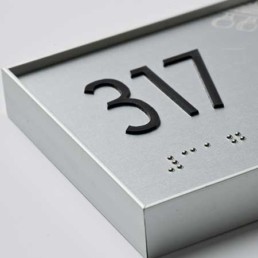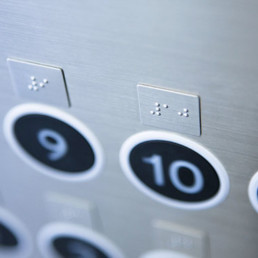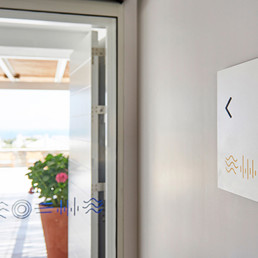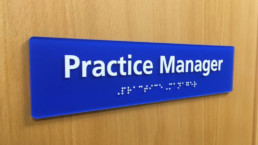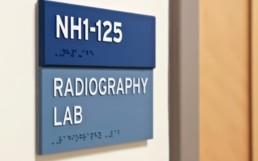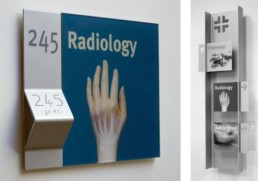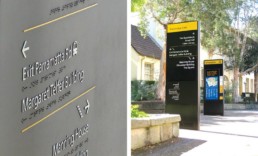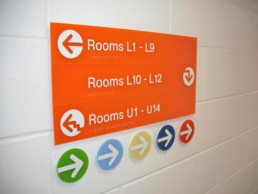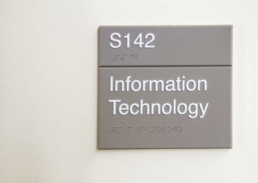Signage is an essential tool for communication with visitors, employees and other members of your company, institution, or organisation. Still, another fact stands for people with disabilities where the general signs might not be enough. Regarding that fact, navigation and wayfinding have become a challenge for visually impaired persons.
Accessibility is something many people with sight will take for granted. It is a major sensory organ that helps us see vital information all the time. From timetables to directions or even signs indicating danger. For those who are visually impaired, this information is accessible and therefore the use of braille and tactile signs is very important.
When it comes to sectors that need the appliance of braille and tactile signs, few of them can be more critical than others such as signage in care homes, or hospitals.
Easily recognisable signage, including the use of tactile and braille signs, plays a vital role in giving visually impaired people the chance to access all the goods, services, and facilities that we take for granted and provide them with a greater level of confidence and independence.
In the majority of the buildings, you will find a variety of braille and tactile signs where their main functions include:
-Providing direction
-Giving Warning
-Supplying Information
-Communicating and Identity
Let’s look at the different sectors that use braille and tactile signs in their signage solutions:
Care Homes
The care home sector is one of the most in-demand sectors for braille and tactile signs. Visually impaired, elderly people are a sensitive group that needs attention to effectively guide them inside and around their care homes. Braille and tactile signs help in recognising their rooms, toilets, dining area etc. Other signs such as common rooms, stairs, and lifts will be easily recognisable to help navigate their living space.

Hotels
Hotels are used all across the world, having different people stay in them consistently. If you’re opening up a hotel or bed and breakfast of your own – there are a few signs that will need to be installed to ensure accessibility for all guests.
Bathroom Signs
Hotels use toilets in different areas making them easily accessible at all times. They use various signs to direct visitors in hotel lobbies, dining areas, spas and gyms. Not all guests will be able to read those signs and including braille and tactile signage makes navigation much easier. These signs should include men, women and baby changing so that guests are heading in the right direction.
Elevator & Stair Signs
Most hotels will also use elevators so employees and guests can move from one floor to another efficiently. With lifts, visually impaired guests will need braille and tactile signs so they can identify specific floors and emergency alarms.
Under certain circumstances, the elevators may not be operational – in this case, the stairs are the only other option. Braille and tactile signs offer navigation and instruction for each floor helping to inform of which floor you may be on at that time.
NHS
The NHS is another sector that needs to have accessibility for people with visual impairment due to the large number of people that attend at all times.
Entrances and Exits
Locating entrances and exits is very important, especially in emergencies. In hospitals and doctors surgeries there will be different departments all with separate entrances and exits and even one way systems you must follow. These signs help direct people to the right areas, making finding a certain ward much easier for those whose sight is impaired.
Education
Educational facilities such as schools, colleges and universities need braille and tactile signs to help their students direct their way around the buildings. In general, most educational institutions feature a variety of signage which will include braille and tactile signs to help those with disabilities. They help to create a fully accessible environment, making sure the students can be independent.
Maintaining the signs:
Care homes, educational institutions, and the NHS as public spaces, have a high number of people accessing them on a regular basis. This means the Braille and Tactile signs are touched regularly, which allows dirt and germs to gather. Here are some simple steps to maintain the lifespan of the signage:
- Use a microfibre cloth or cotton pads.
- Use water and soap or cleaning products (avoid products with chemicals)
- Dry them quickly
If you are looking for professionals to take over the design, manufacture and installation of these signs, please do contact us. Using high-quality materials and working to suit your needs in a timely manner is where we specialise. Contact us here or phone us on 01283 569102.
To find out more, give us a call on 01283 569102 or click the button to chat direct:
Like what you see here?
Get in touch with us to see how we can help your business or brand.
Call us on 01283 569 102
